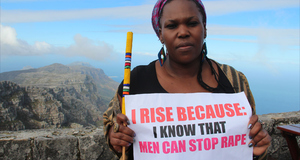Gender-Based Violence in Refugee Camps: Understanding and Addressing the Role of Gender in the Experiences of Refugees
By
2019, Vol. 11 No. 02 | pg. 1/1
IN THIS ARTICLE
KEYWORDS
The discussion of 'women's rights' is often subsumed into the broader consideration of 'human rights,' but when it comes to understanding the experiences of the world's most vulnerable people — refugees — the issue of gender cannot be ignored. The experiences of refugees depend on one’s gender, where women are significantly disadvantaged. Globally, 80% of the refugee and internally displaced people are children and women, which leaves them in a vulnerable position (Qayum, Mohmand and Arooj 2012:63); this includes vulnerability to physical attacks, sexual assaults, and transactional sex (Freedman 2016:21). Moreover, women must also negotiate their roles as primary caretakers and individuals (Cahn and Aoláin 2009:2). However, governments and NGOs are far from active in combatting this violence (Storkey 2015:147). In this analysis, I first provide an overview of the development of gender-based violence (gender-based violence) policies and the feminist stance that this essay takes. Next, I explain gender dimensions in refugee camps. I examine structural violence, specifically looking at the experience of Syrians in Europe. Then, I investigate heterosexual gender-based violence, where I will focus on Afghan women in Pakistan. Further, I evaluate male rape, looking at Syrian males in neighbouring countries. Finally, I conclude with a discussion of measures that must be implemented to address violence facing refugees. Theory and LegislationThe 1951 Refugee Convention was ‘written from a male perspective’, which has shaped the refugee debate for decades (Freedman 2010:591). In 1979, nation-states signed CEDAW, which condemns violence against females (Ward 2002:9). Due to feminist activism (Edwards 2010:23), the UNHCR started adopting documents focusing on refugee women in the 1990s1 (Buscher 2010:6). A decade later, Women’s Commission for Women and Girls (WCRWC) assessed the impact of the Guidelines, and found that, despite some progress, it was not adequate (Freedman 2010:599). This is despite the fact ‘the International Criminal Court adopted the Rome Statute’ in 1998 (Ward 2002:10), where Article 2 ‘Notes that sexual violence constitute a crime against humanity’ (UN Security Council 2013:2), and Article 19 ‘Recognizes the importance of providing timely assistance to survivors of sexual violence’ on various levels2 (UN Security Council 2013:5). Article 25 of the UN Charter affirms that member-states ‘agree to carry out and accept the decisions of the Security Council’ (UN Security Council n.d.), and this formal recognition ought to be brought into practice to prevent sexual gender-based violence in armed conflicts (UN 1998:21).Wies and Haldane (2011:2) define gender-based violence ‘as violence against an individual or population based on gender identity or expression’, where different types of violence reflect gender inequalities based on political, economic, and social structures. This type of violence ‘violate the rights of bodily integrity and security of the person’ (Bond and Phillips 2001:485), and it further affects the victim’s mental, physical, and reproductive health (Wirtz, et al. 2014:2). Hence, violence against women and girls is one of the greatest global human rights violations (Bond and Phillips 2001:481-82). Nevertheless, conflict-based gender-based violence has only gained attention over the past 25 years, which is largely due to feminist research and activism. Ward (2002:7) asserts that this is because of a cultural assumption of the inevitability of mistreatment of women in conflict. Feminists, such as Ward, approach violence by looking at patriarchal terrorism, which refers to social and systematic structures that collectively produce the idea that a man has ownership of ‘his’ woman (Mahoney, Williams and West 2001:146). Therefore, feminists argue, gender-based violence is the outcome of the subordination of women in social structures, which is historically asserted and culturally reproduced (Jasinski 2001:12). Their collaboration with human rights activists, and their fieldwork and theorising, have informed and shaped various international resolutions and recommendations (Edwards 2010:22), and is therefore highly valuable. Accordingly, feminists have urged to investigate both current socio-cultural constructs and the means by which they are constructed (Freedman 2010:593-94); for example, some maintain religion and culture justify violating women’s rights (Bond and Phillips 2001:497). Thus, the flaws in the current rigorous system enable structural and direct violence to thrive. Refugee Camps as GenderedSexual terrorism is, in Brownmiller’s view, ‘a form of social control by men over women’ (Walby 1990:135). In conflict settings, gender roles often change, and feelings of powerlessness and frustration surface (Storkey 2015:134). Evidently, manhood is equated with violence, which can become an amplifying circle (Cahn and Aoláin 2009:6-7). Thus, social patterns and changes hugely shape women’s vulnerability to gender-based violence. Moreover, during conflict, victims experience further stigmatisation and humiliation, which can lead to discrimination, exclusion, and inequality (Ibid:18). Stigma significantly impacts people’s mental health; which can devalue the assaulted person (Javaid 2018:204). Therefore, by emphasising the continuum of violence, it becomes clear that women are vulnerable in these settings (Chakrabarti 2017:109). Refugee camps are gendered on the basis of demographic and economic structures. Given the rapidly changing social, economic, and geographical structure, there is no sense of community, and this fragility surfaces every time a group arrives (Storkey 2015:146). UN funds are often earmarked by donors, which negatively affects gender programmes (Freedman 2010:597). That is, ‘in 2014, only 12% of UN crisis response funding was allocated’ gender-attentive programmes (WHS 2016). Institutionally, the UNHCR, being a bureaucracy, controls refugees; meaning various gender-based initiatives ‘are often designed and implemented without any input from women’ (Freedman 2010:597). Moreover, men and women are presented differently. Women are often symbolised as mothers who protect their children (Ibid:604). Yet, in amalgamating ‘women and children’, they are seen as collectively vulnerable (Ibid:594-95). This media representation appeals to people’s humanitarian sympathy. Consequently, Malkki explains, ‘women are construed as more “true” refugees, being the victims rather than the perpetrators of war and violence’, but this reduces their agency; specifically, women are disempowered, there is a lack of education, individual documentation, economic self-reliance, and unreported gender-based violence (Turner 2000:8). Thus, the international community must advocate for, and ensure, that women’s lost agency, as a consequence of conflict, is not only regained, but that women are empowered on the basis of equal rights and democratic citizenship (Ibid). Structural ViolenceStructural violence, as defined by Galtung, relates to policies and processes that systematically (re)produce socio-economic inequalities (TRLPHDS n.d.), which, in this case, subordinate women. Here I focus on women’s health facilities because of the developmental progress and its link to direct violence (WHS 2016). Essentially, WCRWC (1994) found that vital ‘reproductive health services… were not available to refugee and displaced women’ (Ward 2002:10). Yet, CEDAW’s Recommendation No. 24, Articles 6 and 16 encourage member-states to pay attention to women’s health services (UN Women 2004). In exposing structural violence, there is evidence for improvement; the inter-agency 2004 report, Reproductive Health Services for Refugees and Internally Displaced Persons, identified progress in improved reproductive health programmes. However, the progress is uneven. For example, there is only little improvement in HIV/AIDS and gender-based violence services, STD programmes, and family planning (Buscher 2010:8). Hence, NGOs argue that legal reforms cannot do the work alone. Changes must happen through training sessions, educational workshops, and empowerment projects (Bond and Phillips 2001:486). There is a correlation between reproductive health services and the development of violence against women and girlsG programmes for conflict-affected and refugee women (Ward 2002:10). The WASH Handbook, adopted by many humanitarian organisations, explicitly promotes gender-specific toilets and hygienic care in Chapter 7, Articles 15, 17, and 25 (UNHCR 2018). Therefore, Richter (2011:26) suggests that a standardised checklist must be developed and implemented. This consists of physical, social, and parental services 3. Moreover, it is important to create appropriate examination rooms for women. This means ensuring that female gynaecologists, doctors, pharmacists, and counsellors are available at all times. Syrian Refugees in EuropeStructural violence is a significant problem for Syrian refugees. Globally, there are more than 4.6 million Syrian refugees, where 50.7% are women (Alodaat and Boukhary 2016:20). In Europe, 1.015.500 Syrian refugees have applied for asylum4 (UNHCR 2017). Of these, 29% were women (Connor 2016:12). To clarify, men often travel first to ensure the route is safe, and then women and children travel (WRC 2016:11). Mass migration, due to increased border controls, affects the structure and demographic layout of refugee camps (UNHCR, UNFPA, WRC 2016:3). Regardless, migrants often travel through multiple countries, yet there is currently no cross-border programmes and policies focusing on gender-based violence (WRC 2016:4). Therefore, nation-states and NGOs must, in collaboration with volunteers, women’s rights organisations, and civil society organizations, ensure and promote efficient staff training that is attentive to cross-border protection (UNHCR, UNFPA, WRC 2016:11-12). Multiple reports have assessed structural violence in European refugee camps. Generally, research has found that 46% of women feel unsafe in camps (Al Jazeera 2017). The Women’s Refugee Commission (2016) investigated the Eastern European route. They found that fundamental health care services in transit centres can be difficult to access. Furthermore, there are few interpreters available, which hinders women from seeking help (UNHCR, UNFPA, WRC 2016:8-9); 88% ‘did not know where to obtain contraceptives’, and 25% ‘did not know where to access services if they became pregnant’ (Al Jazeera 2017). Moreover, transit centres are mainly gender-mixed, which leaves women extremely vulnerable (WRC 2016:3-6). Specifically, many women said the poor lightning means that they are afraid of going to the toilet at night (Al Jazeera 2017). Inevitably, multiple accounts explain that girls and women ‘admitted to refusing food and water for multiple days in order to avoid using the latrines, which they perceive as unsafe and unsuitable’ (WRC 2016:3-6). These things also affect women’s mental health, where more than 75% of women in camps have mental and physical health issues – which is linked to their living conditions (UNHCR, UNFPA, WRC 2016:13). Nevertheless, unlike on various Greek islands, Eleonas, Gevgelija, and Tabanovce have ‘separate accommodation for women and children, and segregated water, sanitation and hygiene (WASH) facilities’ (UNHCR, UNFPA, WRC 2016:8-9). Initiatives such as Showers for Sisters near Moria, Lesbos, are therefore crucial to support. James Clarke, founder of RESPOND, read about the horrific rates of ‘harassment and sexual violence endured by women in Moria’ and how it ‘prevents many from bathing or visiting the lavatory (Prisco 2018), so he created a centre. The women-only facility provides toiletries, undergarments, lockable cubicles, a ten-minute shower, a laundry room, a gym and a prayer room. In effect, Fatima tells she had her first shower after six months in the camp (Ibid). Hence, structural violence is based on patriarchal terrorism. The lack of adequate resources affects women’s well-being, leaves them vulnerable, and with little agency. So, European countries must match the international guidelines (Ibid:4); which means accommodation and transit centres must be responsive to females. Moreover, it is critical to have safe-spaces for females. Finally, it is necessary to have trained staff (Ibid:14-17). Currently, it can be concluded that the political and humanitarian response to the refugee crisis, ‘is failing refugee women and girls at every point’ (WRC 2016:13). Direct Violence: Violence Against WomenResearch has found that psychological distress can lead to sexual gender-based violence and intimate partner violence. Fundamentally, violence is a way to reduce/eradicate feelings of helplessness – which many in the diaspora experience (Jasinski 2001:8). Thus, sexual gender-based violence is a reaction to danger after the immediate conflict (Littlewood 1997:12). First, it is important to note that while various acts of gender-based violence are culture-bounded5, rape happens in every society (Storkey 2015:115). The Rome Statute explicitly states that ‘sexual violence constitute a crime against humanity’ (UN Security Council 2013:2). Nonetheless, UN Women estimates that 35% of women ‘have experienced either physical and/or sexual violence… at some time in their lives’ (Chakrabarti 2017:158, UN Women 2015). Radical feminists assert that sexuality and violence are socially shaped. Men’s instrumental socialisation makes them more prone to use ‘violence to settle disputes’ (Walby 1990:134). They affirm ‘that sexual gratification is not the primary motive [for rape]; rather, the objective of rape is control and domination’ (Jasinski 2001:12-13); meaning sexual violence is ‘a gendering act’ that will categorise people into different social roles (Gerecke 2010:142). Moreover, Hanmer (1978) and Hanmer and Sunders (1984) add that ineffective state intervention is hugely problematic in gaining social justice (Walby 1990:135). Generally, sexual abusive acts include: physical and sexual assault, gang/mass rape, forced prostitution, sexual slavery, forced pregnancies, FGM, forced marriages, and transactional sex (WHO Organization 1997). The lines get blurry in intimate relationships, where multiple cultures presume ‘consent to all sexual relations’ when married (Chakrabarti 2017:159). For this reason, marital rape is largely overlooked (Ibid:159-160). In a refugee setting, there are multiple causes of sexual gender-based violence. First, social surroundings can enable assault, where women are more vulnerable. Second, the presence/lack of aid organisations and security workers contribute to violence against women and girlsG opportunities (UNHCR, 1995:para. 1.6). Third, the camp design can permit violence against women and girlsG6 (Chakrabarti 2017:169). Hence, IASC’s (2015) gender-based violence Guidelines state: ‘All humanitarian personnel ought to assume gender-based violence is occurring and threatening affected populations’, and they should take action ‘regardless of the presence or absence of concrete evidence’. Moreover, ‘failure to take action against gender-based violence represents a failure by humanitarian actors’ (UNHCR, UNFPA, WRC 2016:9). Nonetheless, reporting is complicated. First, there is the element of shame – especially regarding female virginity, which is often linked to a family’s honour. These feelings are intensified if the perpetrator is known to the survivor, where the taboo surrounding intimate partner violence often results in a culture of silence. Shame, as potentially the greatest barrier to reporting, is enacted in multiple ways. The first way is a sense of feeing discomfort, humiliation, and disgust. Consequently, this can lead to a feeling of alienation and stigmatisation, which can further damage one’s self-esteem and lead to self-destructive behaviour (Wall n.d.). From a macro perspective, ‘there is a cultural perception of blame on the victim where the society’s attitudes perpetuate myths around gender roles such as that the victim is somehow at fault or that men cannot control their sexual behaviour’ (Ibid). Moreover, if women internalise cultural notions of sexual obligation in marriage, women can feel guilty for not fulfilling their duty. As such, shame, from a sociological perspective, is ‘a “culturally embedded” social process’ (Ibid). Second, on top of the psychological, emotional, physical, and intellectual pain, there is a risk that the woman, and her family, will be ostracised by their community (UNHCR 1995:1.4). Third, refugees fear that reporting will delay their journey (WRC 2016:9). Fourth, survivors often live with their perpetrator, which makes reporting riskier (Mahoney, Williams and West 2001:147). A further challenge is responsibility. The UNHCR (1995) asserts that ‘the Government on whose territory the sexual attack has occurred is responsible for taking diligent remedial measures’ (UNHCR, 1995:ch. 4.1). Therefore, the UNHCR should enact/enforce ‘national laws against sexual violence in accordance with international legal obligations’ (Ibid); for example, ensuring clinical attention for sexual gender-based violence survivors, safe-spaces, gender-based violence experts and counsellors, and a well-functioning referral system (WRC 2016:9). However, there is currently no explicit policy, nor a coordinated cross-border response to care for survivors (WRC 2016:8; Freedman 2016:22). Preventing incidents does not happen by developing response programmes as short-term solutions; but by getting to the root of the problem. Hence, by linking structural and direct violence (Buscher 2010:16). The problem is here that with underreported (S)gender-based violence, NGOs and governments do not take the risk factors seriously, and they therefore do not prioritise improving structural conditions in camps (UNHCR, UNFPA, WRC 2016:7). Nonetheless, staff must be capable of recognising women at risk, and provide physical and mental health services throughout the European route and throughout their time in the camps (WRC 2016:3-4). Afghan Refugees in PakistanAs stated, it is important to see violence against women and girls as a continuum. Afghanistan signed CEDAW, yet the Taliban considered it meaningless (Ward 2002:47). Regarding rape, the Taliban ruled that women need ‘four male witnesses’, otherwise ‘they were at risk of harsh punishment for fornication and adultery’7 (Ibid:47-48). Consequently, this led to a ‘culture of silence’ (Ward 2002:47), which continues in refugee camps. As the conflict escalated in the 1980s, ‘3 million Afghans migrated to Pakistan and at least 75% of them were estimated to be women and children’ (Raheel, et al. 2012:1). Of these, ‘1.2 million live in refugee camps [ARVs] throughout Pakistan’ (Hyder, Noor and Tsui. 2007:1538; Ghufran 2011:947). Up until the Syrian refugee crisis, Pakistan hosted the ‘largest refugee population in the world’ (UNHCR 2010, in Ghufran 2011:945-46). Nevertheless, Pakistan has not signed the UN 1951 Convention Relating to the Status of Refugees nor the 1967 Protocol, yet the UNHCR emphasises that Islamic and Pushtun traditions8 assist with refugee protection (Ibid:948). However, migrating is not necessarily beneficial to Afghan women. The legal system makes it difficult to get justice, and investigators often find sexual gender-based violence too private to examine (Hyder, Noor and Tsui 2007:1537). Specifically, the Qanun-e-Shahadat9 Article 17, diminishes women’s testimony to ‘half of a man’s’, and permits ‘evidence to show that the victim was “immoral”’ (Bond and Phillips 2001:487). Human Rights Watch (1999) found that ‘women in Pakistan face staggeringly high rates of rape, sexual assault, and direct violence while their attackers largely go unpunished’ (Ward 2002:48). Moreover, marital and statutory rape are not considered crimes. The first challenge for humanitarian organisations is therefore to implement CEDAW, since Pakistan has not signed it, but on the 12th Mar 1996, they put down an accession. Still, it is basically impossible for women to gain justice for gender-based violence (Ibid:48-49). Afghan women experience high levels of direct violence. Here, it has been important to use multiple locations to illustrate the severity of violence. The International Rescue Committee (IRC) surveyed more than 200 ‘women living in camps south of Peshawar’ (1998, 47-48). They found that: 79% admitted spousal violence, 39% violence by family members, and 13.4% justified wife beating. Some women claimed direct violence decreased in camps, however the Special Rapporteur (1999) found that intimate partner violence was rising (Ibid:48). Furthermore, a study conducted in Khyber Pakhtunkhwa, found 56% had experienced emotional violence, 46% domestic violence, and 42% physical violence. However, health facilities claimed they only received 6 emotional violence, 5 physical violence, and 1 sexual violence cases per month10 (Qayum, Mohmand and Arooj 2012:64). The small amount of cases is notable. A reason for this, is that the reporting system is underdeveloped, which makes responses insufficient (Hyder, Noor and Tsui 2007:1537). Yet, the main barriers were ‘privacy and the sensitivity of addressing family affairs’ (Ibid:1544). Women’s limited mobility therefore challenges humanitarian work (Ibid:1543). Practices of violence are multi-layered. The first level concerns the social, cultural, and structural risks – this includes the type of marriage, the living situation, and the family dynamic; all of which are subject to changes. Next, there is the dyadic interactions between the woman and her surroundings (i.e. her partner and family-in-law). This is what can lead to conflicts, which then affects their physical and mental health (Hyder, Noor and Tsui 2007:1545). Evidently, parents-in-law contribute to violence against women and girls. A father-in-law was said to have told a woman’s husband to hit her ‘because women should not be given respect… They must be afraid of you’ (Ibid:1542). Moreover, tension between mothers- and daughters-in-law can also increase violence. Here, the husband might physically punish the wrong-doer to end the conflict (Ibid:1543). Nevertheless, women indicated that violence was predominantly verbal, and that ‘there is an expectation of some level of conflict in every marriage’ (Ibid, 1542-43). Consequently, to avoid punishment, women would keep quiet and conform (Ibid:1543). In ARV’s this is likely to become an enormously destructive amplifying circle. Programmes have been constructed by humanitarians to combat sexual gender-based violence. The UNHCR’s sexual gender-based violence working group in Pakistan aims to educate people and create an effective response system (Ibid:1546). In collaboration with IRC and local NGOs, the ‘Women at Risk’ project aims to protect vulnerable women, living with their perpetrator, which is often the case, via resettlement. However, a woman in Islamabad was resettled ‘to work as a domestic servant, which led to repeated rapes committed by her employer against both the woman and her daughter’ (Ward 2002:49). Nevertheless, local NGOs assist women. For example, ‘Struggle for Change (SACH) provides rehabilitation and training for survivors of torture through psychotherapy, physiotherapy, and socioeconomic support’ (Ibid). Additionally, Savera provides similar services for refugee women who are survivors of violence. However, in Peshawar, security concerns stopped the project, and they began focusing on violence against children instead (Ibid). To summarise, gender-based violence exists everywhere, but when the social and moral structure breaks down, women become more vulnerable. gender-based violence is about control, and between conflict and peace, men become more dominating. In ARVs, women experience higher levels of gender-based violence than the global estimate. Women perform subordinate gender roles to avoid violence, and social stigma and inadequate support systems prevent women from reporting. These problems challenge humanitarian initiatives regarding resettlement, female empowerment, and the legal system. Male RapeHowever, sexual violence also affects men. For decades, sexual assault has been framed as male perpetrators and female victims (Javaid 2016:284). Consequently, by ignoring male rape, feminist discourse, according to Cohen (2014), reinforces hegemonic masculinities and a patriarchy (Ibid:286), meaning many male survivors are met with scepticism (Javaid 2018:205). Additionally, given men’s socialisation, ‘male rape victims are placed at the bottom of the gender hierarchy’ and they are therefore not considered ‘real’ men (Ibid:200). Fundamentally, there is a core ‘belief that male rape is homosexual sex, that only homosexual men get raped and only homosexual men perpetrate rape’; this is a myth (O'Brien, Keith and Shoemaker 2015:359)! As a result, men feel discouraged from reporting since they worry about being labelled inadequate, unmanly, or weak (Sleath and Bull 2010:973-74). Consequently, male sexual harassment is underreported (O'Brien, Keith and Shoemaker 2015:358). Now, Stanko (1990) claims that male rape is driven by the same reasons as those of women; ‘to exercise power and control over the victim’ (Javaid 2016:283). Thus, male rape is an ‘extension of male power and control over women’, which constitutes a power structure (Ibid:284). It is therefore important to note that rape happens to both men and women (Cahn and Aoláin 2009:22). Male rape has serious psychological and physical consequences. First, they are likely to feel ‘”insufficient justification” guilt’ if they did not fight back (O'Brien, Keith and Shoemaker 2015:361). Second, there is a high risk that they will suffer from mental health issues such as depression, PTSD, low self-esteem, sexual dysfunction, revenge fantasies, and gender and sexuality identity questioning (Davies, Gilston and Rogers 2012:2808). Because of their socialisation, scholars claim that survivors ‘may reaffirm their masculinity through’ physical violence, risk-taking behaviour, and by ‘demonstrating an ability to care for themselves by not reporting the crime’ (Javaid 2016:288). This control element can lead to more violence against women. Male Rape in MENAAs stated, sexual violence ‘in Syria is designed to humiliate and subjugate individuals, families, and communities’ (Chynoweth 2017:39). sexual violence against men in conflict areas are severely underestimated, yet multiple reports ‘confirm the presence of sexual violence against males in the MENA region, especially in the context of forced and irregular migration, unrest, and armed conflict’ (Ibid:-13-14). Moreover, refugees in Jordan considered ‘boys more at risk for sexual violence than girls’, given virginity is not an issue, and because boys’ movement are not as restricted as girls (Ibid:30). Furthermore, a woman in the Kurdistan Region of Iraqasserted that ‘rape [of young boys] is happening on a daily basis’; especially in bathrooms, camp peripheries, uncompleted buildings, caravans, and homes (Ibid:31). Male rape is hugely underreported. Barriers to reporting include: social stigmatisation, ineffective identification mechanisms, dismissive attitudes among staff, legislative barriers, underfunding, and lack of institutional responsibility (Ibid:8). Moreover, the underlying notion of masculinity and victimisation as an oxymoron means men are unlikely to seek support (Ibid:16). Specifically, a MHPSS Officer in the Kurdistan Region of Iraqstated: ‘community stigma is the biggest issue for these men… He would not be respected as a man… He will be known as weak, incompetent, and inappropriate’ (Ibid:37). Additionally, some refugees fear that reporting will prompt refoulement (Ibid:56). Because of the acceptance of inevitable violence against women and girls, most programmes are, while being open to males, focused on females. Moreover, staff are predominantly women, and most do not have experience with male rape (Ibid:43). Not only is this a social phenomenon, but financial investment also primarily focuses on female abuse (Ibid:63). Consequently, a sexual gender-based violence Officer in the Kurdistan Region of Iraqexplained that they often do not know where to refer men to (Ibid:45). Therefore, in Iraq, ‘none of the organisations reported receiving male Syrian survivors in the Kurdistan Region of Iraqsince the gender-based violence information management system was launched in 2015’ (Ibid:40). In Jordan, only 8.4% of sexual gender-based violence incidents were against males; 70% were committed by adults. In Lebanon in 2015, 22% of rape, and 18% of sexual assault reports were by men (Ibid:40-41). Nevertheless, males have been ‘integrated into some key strategy documents’11 (Ibid:44). However, the ‘communication gaps between service providers and refugees, as well as UNHCR and service providers, hinder survivors from accessing services’ (Ibid:55). This becomes a vicious cycle of limited outreach, socio-cultural barriers, inaccessible services, and low reporting, which reinforces a myth ‘that sexual violence against men is rare’ (Ibid:66). Therefore, one must not feminise rape. Men are victims of gender-based violence, and they are often in a vulnerable social situation. Because of this, male sexual assault is underreported, which makes it harder to address. This is evident in Syrian camps in MENA countries. Despite evidence of high rates of sexual violence against men, the barriers faced by men often holds them back from reporting, which have crucial effects on their identity and health. ConclusionThere are measures humanitarians can take to combat violence. First, it is crucial to apply a gender lens in refugee situations. Otherwise, the practices and policies will remain ineffective (Cahn and Aoláin 2009:10); being culturally sensitive, this calls for gender specific programmes (Chynoweth 2017:54). Second, nation-states must be held accountable to international norms (Gururaja 2000:16). Thus, donor countries ought to re-evaluate their commitments to refugees regarding violence (Ward 2002:15). Third, women must be taught ‘their legal rights and responsibilities’ via culturally sensitive information campaigns (UNHCR, 1995:para. 2.4). Fourth, terminology that reaffirms a patriarchy must be deconstructed12 (Grabska 2011:91). Finally, men must be engaged in gender equality conversations. Addressing both violence against women and girlsG and sexual violence against men is beneficial to entire communities (Buscher 2010:18-19; Chynoweth 2017:66). In conclusion, refugee camps are gendered due to demographic structures, lack of cultural sensitivity, and parental roles. Here, structural violence is based on a patriarchal model, which reaffirms socio-economic inequalities, and neglects women’s special needs. Second, direct violence against women and girls must be seen as a continuum that escalates during conflict; humanitarians are challenged by cultural norms of consent and a lack of international responsibility. Third, feminism might underestimate the impact of sexual violence against men; it is widespread. The socio-cultural views on masculinity and heterosexuality have huge impacts on the survivor. Actors must therefore deconstruct rape and create effective reporting systems specialising in male abuse. Future research should challenge patriarchies and gender peformativity in conflict zones. Furthermore, a culturally sensitive scheme must be implemented to support quantitative researchers’ quest of conceptualising gender-based violence in refugee camps. DedicationThis essay is dedicated to all the refugee women who are survivors of gender-based violence, yet whose voices have not been heard. Because they do not know where or how to report abuse. Because they have not been told about their human rights. Because of the stigma they can face given their cultural background. This essay is dedicated to all the refugee men who have survived male sexual violence and who have been silenced because of social constructs. Because they can face humiliation if they report the assault. Because it questions their gender identity. Because it questions their sexual identity. This essay is written with a hope for focused action from international political organisations, governments, NGOs, donors, and individuals to effectively use a gendered lens in humanitarian work. ReferencesAl Jazeera. 2017. RRDP: Women fear violence and rape in refugee camps. Accessed Mar 7, 2018. https://www.aljazeera.com/news/2017/01/rrdp-women-fear-violence-rape-refugee-camps-170123180556027.html. Alodaat, L., and S. Boukhary. 2016. Violations against women in Syria and the disproportionate impact of the conflict on them – Universal Periodic Review of the Syrian Arab Republic submission to the Human Rights Council. New York: Women's International League for Peace and Freedom. Bond, J., and R. Phillips. 2001. "Violence Against Woman as a Human Rights Violation: International Institutional Responses." In Sourcebook on Violence Against Women, edited by C. M. Renzetti, J. L. Edleson and R. K. Bergen, 481-499. London: Sage Publication. Buscher, D. 2010. "Refugee Women: Twenty Yeas On." Refugee Survey Quarterly (UNHCR) 29 (2): 4-20. Cahn, N., and F. N. Aoláin. 2009. "Hirsch Lecture: Gender, Masculinities, and Transition in Conflicted Societies." New England Law Review 44 (1): 1-24. Chakrabarti, S. 2017. Of Women: In the Twenty-First Century. London: Allen Lane. Chynoweth, S. 2017. Sexual Violence Against Men and Boys: In the Syrian Crisis. Geneva : UNHCR. Connor, P. 2016. Number of Refugees to Europe Surges to Record 1.3 Million in 2015. Pew Research Center. Davies, M., J. Gilston, and P. Rogers. 2012. "Examining the Relationship Between Male Rape Myth Acceptance, Female Rape Myth Acceptance, Victim Blame, Homophobia, Gender Roles, and Ambivalent Sexism." Journal of Interpersonal Violence 27 (14): 2807-2823. Edwards, A. 2010. "Transitioning Gender: Feminist Engagement with International Refugee Law and Policy 1950-2010." Refugee Survey Quaterly 29 (2): 21-45. Freedman, J. 2010. "Mainstreaming gender in refugee protection." Cambridge Review of International Affairs 23 (4): 589-607. Freedman, J. 2016. "Sexual and gender-based violence against refugee women: a hidden aspect of the refugee "crisis"." Reproductive Health matters 24: 18-26. Gerecke, M. 2010. "Explaining Sexual Violence in Conflict Situations." In Gender, War, and Militarism: Feminist Perspectives, edited by L. Sjoberg and S. Via, 138-154. Santa Babara: ABC-CLIO. Ghufran, N. 2011. "The Role of UNHCR and Afghan Refugees in Pakistan." Strategic Analysis 35 (6): 945-954. Grabska, K. 2011. "Constructing 'modern gendered civilised' women and men: gender-mainstreaming in refugee camps." Gender & Development 19 (1): 81-93. Gururaja, S. 2000. "Gender dimensions of displacement." Forced Migration Review 9: 13-16. Hyder, A. A., Z. Noor, and E. Tsui. 2007. "Intimate partner violence among Afghan women living in refugee camps in Pakistan." Social Science & Medicine 64: 1536-1547. Jasinski, J. L. 2001. "Theoretical Explanations for Violence Against Women." In Sourcebook on Violence Against Women, edited by C. M. Renzetti, J. L. Edleson and R. K. Bergen, 5-21. London: Sage Publications. Javaid, A. 2016. "Feminism, masculinity and male rape: bringing male rape 'out of the closet'." Journal of Gender Studies 25 (3): 283-293. Javaid, A. 2018. "Male rape, masculinities, and sexualities." International Journal of Law, Crime and Justice 52: 199-210. Littlewood, R. 1997. "Military Rape." Anthropology Today 13 (2): 7-16. Mahoney, P., L. M. Williams, and C. M. West. 2001. "Violence Against Women by Intimate Relationship Partners." In Sourcebook on Violence Against Women, edited by C. M. Renzetti, J. L. Edleson and R. K. Bergen, 143-178. London: Sage Publications. McGinnis, R. E. 2016. "Sexual Victimization of Male Refugees and Migrants: Camps, Homelessness, and Survival Sex." Dignity: A Journal on Sexual Exploitation and Violence 1 (1): Art. 8. O'Brien, C., J. Keith, and L. Shoemaker. 2015. "Don't Tell: Military Culture and Male Rape." Psychological Services 12 (4): 357-365. Prisco, J. 2018. Women-Only Washrooms Restore Dignity to Refugees in Greece. July 11. Accessed July 31, 2018. https://www.globalcitizen.org/en/content/refugee-women-greece-washrooms-showers-for-sisters/?utm_source=twitter&utm_medium=social&utm_content=global&utm_campaign=general-content&linkId=54249700. Qayum, M., S. Mohmand, and H. Arooj. 2012. "Frequency and Physical Factors Associated with Gender-Based Violence in the Internally Displaced People of Pakistan." Journal of the College of Physicians and Surgeons Pakistan 22 (1): 63-65. Raheel, H., M. S. Karim, S. Saleem, and S. Bharwani. 2012. "Knowledge, Attitudes and Practices of Contraception among Afghan Refugee Women in Pakistan: A Cross-Sectional Study." PLoS One 7 (11): 1-7. Richter, R. 2011. "Disparity in Disasters: A Frontline View of Gender-Based INequities in Emergency Aid and Health Care." In Anthropology at the Front Lines of Gender-Based Violence, edited by J. R. Wies and H. J. Haldane, 19-28. Nashville: Vanderbilt University Press. Sleath, E., and R. Bull. 2010. "Male Rape Victim and Perpetrator Blaiming." Journal of Interpersonal Violence 25 (6): 969-988. Storkey, E. 2015. Scars Across Humanity: Understanding and Overcoming Violence Against Women. London: SPCK Publishing. The Religious Literacy Project, Harvard Divinity School. n.d. Typologies of Violence and Peace. Accessed August 1, 2018. https://rlp.hds.harvard.edu/typologies-violence-and-peace. Turner, S. 2000. "Vindicating masculinity: the fate of promoting gender equality." Forced Migration Review 9: 8-9. UN Security Council. 2013. "Security Council resolution 2106: on sexual violence in armed conflict, S/RES/2106." Jun 24. Accessed Mar 4, 2018. http://www.refworld.org/docid/51d6b5e64.html. UN Women. 2004. Convention on the Elimination of All Forms of Discrimination against Women: General Recommendations made by the Committee on the Elimination of Discrimination against Women. Accessed Mar 4, 2018. http://www.un.org/womenwatch/daw/cedaw/recommendations/index.html. UN Women. 2015. Violence Against Women. Accessed Mar 7, 2018. http://interactive.unwomen.org/multimedia/infographic/violenceagainstwomen/en/index.html. UNHCR. 1995. "Guidelines on Prevention and Response." Accessed Mar 6, 2018. https://www.un.org/ruleoflaw/files/unhcr-violence-mar95.pdf. UNHCR. 2016. UNHCR viewpoint: ‘Refugee’ or ‘migrant’ – Which is right? Accessed Mar 7, 2018. http://www.unhcr.org/uk/news/latest/2016/7/55df0e556/unhcr-viewpoint-refugee-migrant-right.html. UNHCR. 2017. Europe: Syrian Asylum Applications. Accessed Mar 7, 2018. http://data.unhcr.org/syrianrefugees/asylum.php. UNHCR. 2018. Emergency Handbook: WASH in camps. Accessed Mar 5, 2018. https://emergency.unhcr.org/entry/39930/wash-in-camps. UNHCR, UNFPA, Women's Refugee Commission. 2016. INITIAL ASSESSMENT REPORT: Protection Risks for Women and Girls in the European Refugee and Migrant Crisis. New York: UNHCR, UNFPA, Women's Refugee Commission. United Nations Security Council. n.d. Frequently Asked Questions. Accessed Mar 5, 2018. http://www.un.org/en/sc/about/faq.shtml#binding. United Nations. 1998. "Sexual Violence and Armed Conflict: United Nations Response." April. Accessed Mar 1, 2018. http://www.unwomen.org/-/media/headquarters/media/publications/un/en/cover.pdf?la=en&vs=954. Walby, S. 1990. Theorizing Patriarchy . Oxford: Blackwell Publishers. Wall, L. n.d. The many facets of shame in intimate partner sexual violence. Accessed Aug 27, 2018. https://aifs.gov.au/publications/many-facets-shame-intimate-partner-sexual-violence/export. Ward, J. 2002. If Not Now, When? Addressing Gender-based Violence in Refugee, Internally Displaced, and Post-conflict Settings: A Global Overview. New York: The Reproductive Health for Reguees Constortium . Wies, J. R., and H. J. Haldane. 2011. "Ethnographic Notes from the Front Lines of Gender-Based Violence." In Anthropology at the Front Lines of Gender-Based Violence, edited by J. R. Wies and H. J. Haldane, 1-17. Nashville: Vanderbilt University Press. Wirtz, A. L., K. Pham, N. Glass, S. Loochkartt, T. Kidane, D. Cuspoca, L. Rubenstein, S. Singh, and A. Vu. 2014. "Gender-based violence in conflict and displacement: qualitative findings from displaced women in Colombia." Conflict and Health 8 (10): 1-14. Women's Refugee Commission. 2016. No Safety for Refugee Women on the European Route: Report from the Balkans. New York: Women's Refugee Comission. World Health Organization. 1997. Violence against women: In situations of armed conflict and displacement. Geneva: World Health Organization. World Humanitarian Summit. 2016. "Women and Girls: Catalysing Action to Achieve Gender Equality." Apr 25. Accessed Feb 22, 2018. https://www.agendaforhumanity.org/sites/default/files/resources/2017/Jul/WOMEN_AND%20GIRLS-CATALYSING_ACTION_TO_ACHIEVE_GENDER_EQUALITY_0.pdf. Endnotes1.) i.e. the 1991 Guidelines on the Protection of Refugee Women 2.) This includes psychological well-being, physical and sexual health, legal assistance, livelihood support, and other areas 3.) This includes: undergarments, contraceptives, sanitary products, antifungal infection products, rape intake, (S)gender-based violence counsellors, safe-spaces, crisis meeting groups, breastfeeding area and supplies, child support services, pregnancy tests and registries, vitamins, delivery kits, ultrasound equipment, vaccines, and infant care kits 4.) Between Apr 2011 and Dec 2017 5.) I.e. honour killings, FGM, and selective abortion 6.) I.e. shelters make rape and survival sex commonplace, and the demeaning conditions become accepted by displaced women 7.) For example, IRC (2016) reports a 16-year-old girl from Kabul reported to the government that her father sexually abused her. He was sentenced to life. However, she got a four-year sentence because she did not stop the assault earlier 8.) Especially malmastia (hospitality) and panah (refuge) 9.) Law of Evidence Order, 1984 10.) This is well above the UN Women (2015) estimates of 35% - see p. 10 11.) The 2016 Iraq gender-based violence Sub-Cluster Strategy; The 2017-2020 Lebanon Crisis Response Plan; the 2015-2017 gender-based violence Sub-Working Group Strategy in Jordan; and the 2017-2019 Jordan Response Plan 12.) Such as men as ‘perpetrators’ and women as ‘victims’ Suggested Reading from Inquiries Journal
Inquiries Journal provides undergraduate and graduate students around the world a platform for the wide dissemination of academic work over a range of core disciplines. Representing the work of students from hundreds of institutions around the globe, Inquiries Journal's large database of academic articles is completely free. Learn more | Blog | Submit Latest in Women's & Gender Studies |


















